Kwitonda and Inzuvo
By Gorilla Doctors Staff on Wednesday, June 16th, 2010 in Uncategorized.There are still many days when I am in the Virungas I can’t quite believe I work here. This was one of those days. As trackers Jerome and Aaron and I walked up the mountain on our way to find Kwitonda group, I was learning new Kinyarwanda words. I had learned the Kinyarwanda word for elephant a few weeks ago. Izuvo. Tembo in Swahili. Elephant. I told them I really wanted to see a forest elephant some day. Jerome laughed and said he saw an elephant here just 4 days ago, so I was on the look-out as we walked. We found evidence of elephants almost immediately! Along the main path, and even when we veered off the path to find the gorilla night nests, it was clear that elephants had been here recently. However today this evidence was as close as I got to seeing an elephant, but even this was exciting.
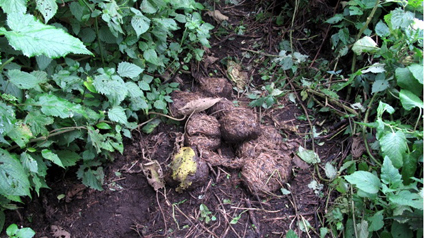 Jerome said this pile was 3-4 days old. They were close!
Jerome said this pile was 3-4 days old. They were close!
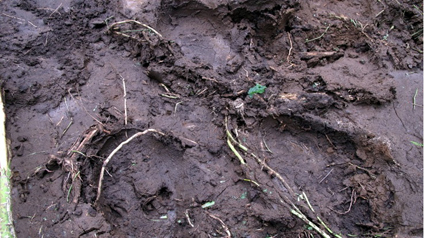 This is as close as I got to an elephant today – fresh foot prints…
This is as close as I got to an elephant today – fresh foot prints…
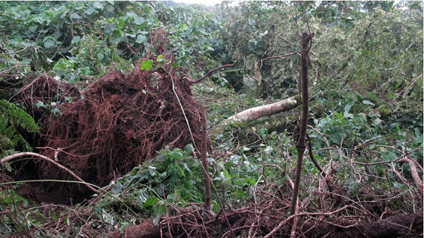 Evidence of elephants…swath of destruction.
Evidence of elephants…swath of destruction.
The downside to having elephants in this area was that it made tracking the gorillas difficult – there were so many paths of destruction through the thick vegetation. Jerome and Aaron persisted and within the hour we found evidence of gorillas – a smaller swath of destrction, and a tree that had been striped of its bark (gorillas really like the pulp of some tree species). It was Kwitonda group. We could hear them, and smell them, but seeing them was another matter. The vegetation was thick and tall in this place.
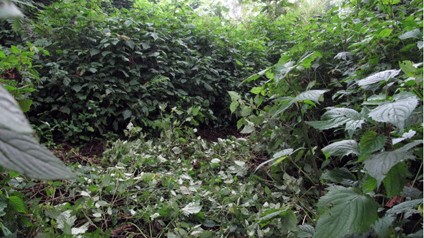 Gorilla trail through the vegetation.
Gorilla trail through the vegetation.
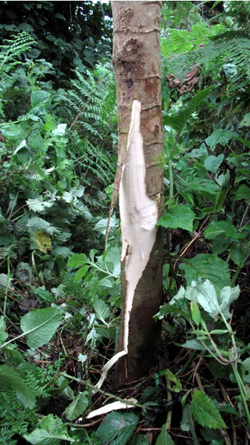 Evidence of gorillas!
Evidence of gorillas!
Kwitonda group is composed of 19 individuals. There are 3 silverbacks, Kwitonda himself, and his two deputies Kigoma and Akarevuro. There are also 2 black backs, Magumu and Marambo, who are growing fast. Then come the 4 adult females, Kibyeyi, Mbilimbili, Mugeni, and Nyiramurema, and their assorted offspring. It is a nice, generally peaceful group. Jerome and I were trying very hard to view at least a few of these individuals as we carefully picked our way through the foliage. Mbilimbili was pregnant and due any day – I was hoping to get at least a glimps of her! At one point we could finally see the top of Kwitonda’s head surrounded by various hues of green leaves, but that was all. We could hear babies and juveinles all around him, grunting and laughing as they tumbled. Bushes shook violently as they chased and wrestled, but we could see nothing but Kwitonda’s head! It is not unusual to have most of a gorilla group’s juveniles and infants near the main silverback – they feel safe and content by his side. Kwitonda sat patiently amidst the turmoil of his children’s play.
Jerome and I circled widely and tried to find advantage on higher ground, but along the way we found Akarevuro sitting in our path. We observed him for a bit, and then waited respectfully until he moved on. We continued our search for a good view of Kwitonda and the rest of the family, and were finally rewarded. In a small opening we could see a group of gorillas resting quietly.
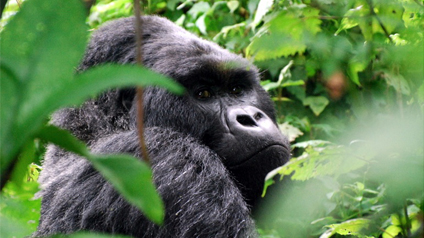 Akarevuro, silverback who is second in command to Kwitonda.
Akarevuro, silverback who is second in command to Kwitonda.
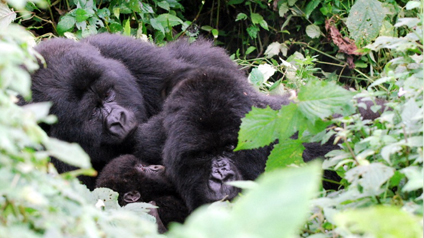 A content group of gorillas resting. Nyiramurema’s baby was born in December.
A content group of gorillas resting. Nyiramurema’s baby was born in December.
We watched these girls for some time as they groomed one another, munched on some yummy vines and rested, until they moved on. Then we moved on to continue our search for the rest of the group. We could hear the ubiquitous passing of gas (a product of their herbivorous diet!), hear tree limbs breaking and crashing to the ground, and at one point we knew there were gorillas less than 7 meters away, with a great walls of vegetation separating us. Jerome used his panga carefully to cut through some of that greenery, and saw Kibyeyi’s infant peeking through the leaves. Clear eyes, clean nose, alert and responsive – the picture of health.
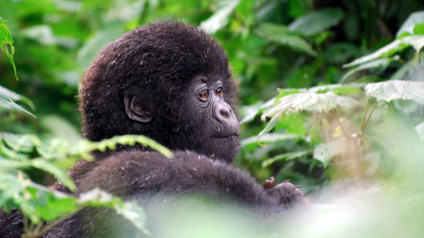 Kibyeyi’s infant (a year old) peeking through the vegetation.
Kibyeyi’s infant (a year old) peeking through the vegetation.
The rest of the group had taken to the trees in the area to eat a vine that they particularly love. Even Kwitonda was high in the tree, but on the most sturdy branches! We were able to spot everyone in the group, and alas Mbilimbili had not yet had her baby. The group looked healthy, happy and content today. On our way back to the other trackers we spied Akarevuro copulating with Sulubika, a juvenile female, about 8 years old. That’s a little young, but I’ll let you know in 9 months if it was a successful mating! We also got a good look at Mugamu, as he elbowed his way past Chili, a young female, down a tree limb to get a better look at us. At one point he gently stepped on her to get past, and she held her ground! He checked us out for some time, and then decided we were boring and went back to the trees.
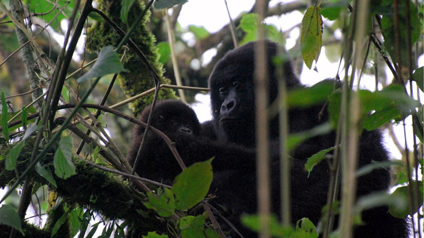 They took to the trees toward the end of our time with the group.
They took to the trees toward the end of our time with the group.
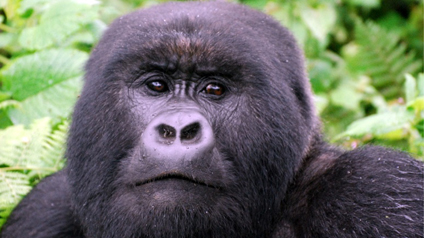 Magumu, a black back, checking us out.
Magumu, a black back, checking us out.
I learned that Mbilimibili gave birth 2 days after I visited the group! A healthy baby so far – I hope to visit the group again soon to see the new addition to this mountain gorilla family.
Help the Gorilla Doctors: Donate and/or Become a Gorilla Orphan Guardian™ today!


 Donate
Donate